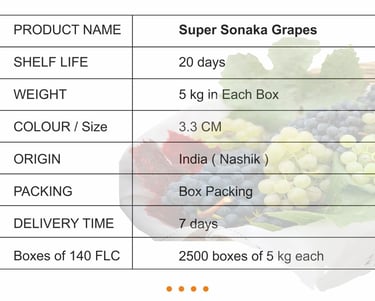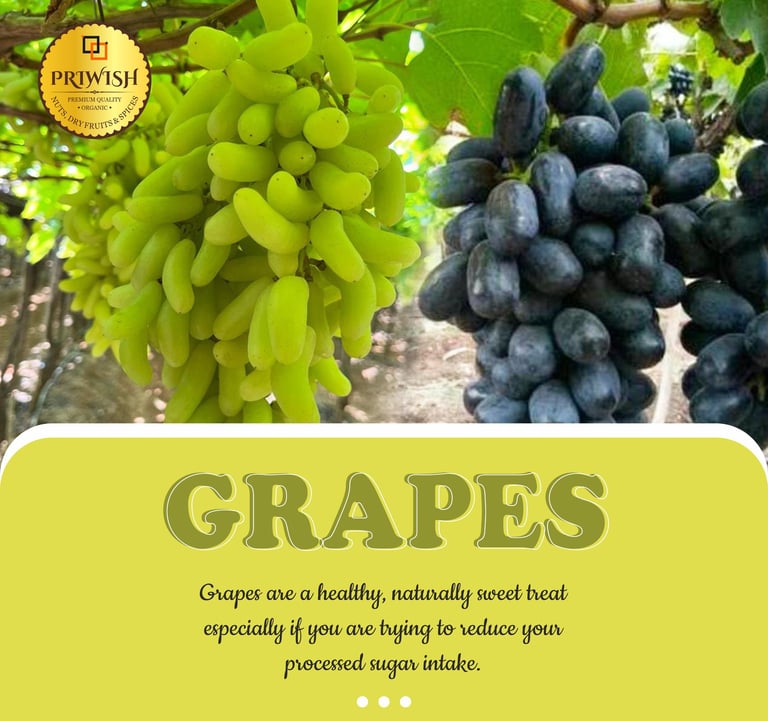India is a significant exporter of grapes, offering a variety of cultivars known for their unique flavors and characteristics. Here’s a detailed overview of some key types of grapes exported from India:
1. Thompson Seedless:
-Characteristics: Small to medium-sized, greenish-yellow grapes.
- Flavor: Sweet and juicy with a hint of muscat.
- Usage: Ideal for fresh consumption, raisin production, and wine-making.
- Export Significance: Among the most widely exported grape varieties from India.
2. Sharad Seedless:
-Characteristics: Medium-sized, oval-shaped, and red/purple in color.
- Flavor: Sweet and slightly tangy.
- Usage: Primarily exported as table grapes.
- Export Significance: Gaining popularity in international markets.
3. Sonaka (Sugraone):
- Characteristics: Large, elongated, and green to light green in color.
- Flavor: Sweet and crisp.
- Usage: Preferred as fresh table grapes.
- Export Significance: Known for its export-quality characteristics.
4. Manik Chaman:
- Characteristics: Medium-sized, round, and dark red to purple.
- Flavor: Sweet and mildly acidic.
- Usage: Primarily exported for fresh consumption.
- Export Significance: Gaining recognition in international markets.
5. Arkavati (Arkavathy):
- Characteristics: Medium to large-sized, round, and dark red/purple.
- Flavor: Sweet and aromatic.
- Usage: Suitable for fresh consumption and table grape exports.
- Export Significance: Gaining popularity in global markets.
6. Black Beauty (Bangalore Blue):
-Characteristics: Medium-sized, round, and deep purple to black.
- Flavor: Sweet and intense.
- Usage: Exported as table grapes and occasionally for wine-making.
- Export Significance: Recognized for its distinctive appearance and taste.
7. Rishad Seedless:
-Characteristics: Medium-sized, oval-shaped, and red/purple.
- Flavor: Sweet with a hint of muscat.
- Usage: Exported for fresh consumption and raisin production.
- Export Significance: Contributing to India’s diverse grape exports.
Varieties of Grapes Majorly Exported from India:
1. Thompson Seedless:
- Origin: Predominantly grown in the Nashik region of Maharashtra.
- Export Packing: Packed in ventilated cartons or punnets to ensure freshness during transit.
- Quality: Globally recognized for their sweet taste, golden color, and plump berries.
2. Bangalore Blue:
- Origin: Primarily cultivated in Karnataka.
- Export Packing: Carefully packed in clamshell containers or punnets to prevent bruising.
- Quality: Known for their deep blue-purple hue, these grapes boast a unique flavor profile and are popular in international markets.
3. Sharad Seedless:
- Origin: Cultivated in various grape-growing regions, including Maharashtra.
- Export Packing: Typically packaged in protective corrugated boxes to maintain quality during shipment.
- Quality: Recognized for their large berry size, crisp texture, and sweet taste.
4. Manjri Naveen:
- Origin: Grown in Pune and other regions of Maharashtra.
- Export Packing: Carefully packed in foam or bubble wrap to prevent damage during transportation.
- Quality: These grapes are appreciated for their vibrant color, seedlessness, and refreshing taste.
5. Beauty Seedless:
-Origin: Predominantly cultivated in Maharashtra.
- Export Packing: Packaged in perforated plastic bags within cartons to ensure optimal freshness.
- Quality: Characterized by their elongated shape, thin skin, and sweet flavor, making them a sought-after export variety.
Export Origin and Quality Control:
- Grapes for export are primarily sourced from grape-growing regions in Maharashtra, Karnataka, and other suitable climates.
-Stringent quality control measures are implemented to meet international standards, ensuring that only the finest grapes are exported.
Export Packing:
-Grapes are meticulously packed in accordance with global packaging standards to preserve freshness during transit.
- Common packaging materials include ventilated cartons, punnets, clamshell containers, and protective wraps.
Quality Standards:
-Grapes exported from India adhere to international quality benchmarks, focusing on factors such as size, color, sweetness, and overall appearance.
- Quality control processes are implemented at various stages, from cultivation to packaging, to ensure a premium product reaches global markets.
India's grape varieties, known for their diverse flavors and qualities, continue to make a mark in the international market. With careful cultivation, stringent quality control, and optimal packaging, Indian grapes stand out as a reliable and flavorful choice for consumers worldwide.
….




....
© 2017 - 2025 Priwish Enterprises I All Rights Reserved.
Quick Links
